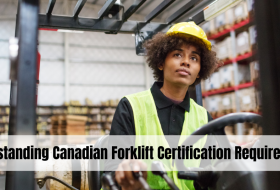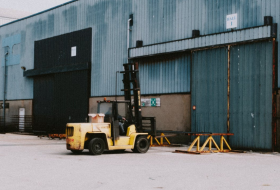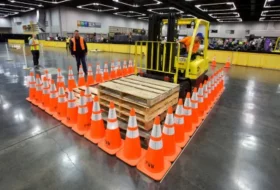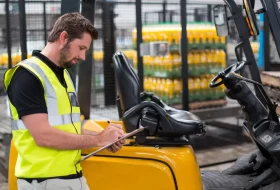Many industries have forklifts as a regular sight. Forklifts are essential tools in many industries, whether they are used in warehouses or manufacturing facilities, retail apps, and other locations. Many operators and pedestrians are prone to becoming complacent about safety procedures due to the frequent use of forklifts. Complacency can lead to many problems, such as asset damage, employee discipline, fines, injury, or even death.
According to the Operational Safety and Health Administration, on average 100 workers are killed in forklift crashes each year. Additionally, there could be as many as 95,000 forklift incidents per year. These accidents can often be avoided. Safety is a top priority when making Wisdom forklifts. However, with the best forklift training and if pedestrians and operators follow safety protocols, these type of accidents can be minimized.
The Importance of Inspection
Injuries and deaths can also be caused by equipment failure. This is because employees fail to properly inspect and evaluate equipment before it is used. Although safety regulators, forklift manufacturers, as well as many companies, encourage forklifts to be inspected before they are used, these inspections are often overlooked or poorly documented. Safety is the main concern for the inspections should be conducted regularly, and so is compliance–thousands of dollars in fines could be levied based on failure to determine forklift safety before operation. Forklift training in Oakville provides the necessary training for pre-check and safe operation of forklifts.
Pre-operation forklift inspections must be performed according to the checklist. It helps to protect the company’s reputation, financial stability, and machine failures. Along with safety and compliance, it also provides a cost-savings opportunity through proactive maintenance and the discovery and prevention of potential problems. It is easier to fix a problem or prevent it from becoming a serious issue than to wait for the full-blown thing to happen. A pre-operation inspection program requires constant corporate support and high levels of operator discipline.
What must be done during forklift inspection?
OSHA stipulates that forklifts should be inspected daily or every shift if they are used continuously. Report any problems immediately and remove the forklift from service. There are best practices that can be used to inspect forklifts, but there aren’t any specific requirements in the standard.
Do not panic if you don’t have a pre-operational checklist. They are quite intuitive. Manufacturers provide checklists that can be modified and updated as needed. These instructions are the best way to go. These are some examples of checklists you should include in your forklift inspection.
- Check the levels of fluids (oil, water, and hydraulic fluid, among others).
- Forklifts should be inspected for cracks, leaks, and other visible defects.
- Visually inspect mast chains; do not use your hands to check them.
- Check mast chain tension by raising the load backrest at eye level. The mast chains should be straight and not tilted.
- Examine the condition of your tires, check the pressure and look out for any cuts or gouges.
- Check fork condition. You must inspect the heel and top clip retaining pin.
- Ensure load backrest extension functions properly.
- Verify the functionality of finger guards.
- Safety decals and nameplates should be legible and match the model of your forklift.
- Ensure to fill the logbook and operators’ manual on daily basis.
- Make sure the manual compartment of the operator is free from debris.
- All safety devices such as seatbelts and horns should be tested.
- For proper functioning, check the brakes and steering controls.
Electric Forklifts Preoperative Checklist
These are some things you should check on your electric lifts.
- Cables and connectors are free from fraying and exposed wires
- Functional battery restraints can be used
- The proper levels of electrolytes
- The hood latch works as intended
Pre-operation Checklist
These are some things to check on your internal combustion cushion or pneumatic forklifts.
- The proper levels of engine oil and engine coolant are maintained
- Clean and in good condition, air filters
- The radiator has no cracks or other defects
- The hood latch works as intended
Reach Trucks Preoperative Checklist, and Order Pickers Prior-operations List
These are some things you should check on your reach truck or order pickers.
- Both on-truck and off truck chargers work
- There is no damage to the backrest or forks.
- Effective brake pedal
- There are no leaks to be found
Safety Tips for Forklift Maintenance
- Do a Daily Inspection:
Before you use your forklift, make sure to inspect it for any potential problems like worn brakes or leaky hoses. This will ensure that your forklift is safe. You can also save money and time on costly repairs. Wisdom forklift, the best forklift training centre in Oakville, covers all these topics in depth to ensure the safety of all employees. Before you turn on your machine, make sure to check the hoses, tire pressure, conditions, seat belt function, and fluid levels.
- View the Maintenance Schedule of the Manufacturer:
Stick to the manufacturer’s maintenance plan. Most manufacturers recommend that you have an in-depth inspection of your vehicle after a specified time.
- Check the Tires:
Tires on forklifts are more likely to wear quickly if they travel over the same routes throughout the warehouse. Many things can happen to tires, including tire deflation, loss of tread, or leakage. Also inspect them visually for any signs of damage.
- Clean It
Clean your forklift will not only make it look great, but it also helps to remove combustible materials like lint and dirt.
- Fix the problem As Soon as Possible:
Even though you have a routine forklift maintenance program, unexpected problems can sometimes occur with your machine. It is important to address problems as soon as possible to prevent bigger problems or accidents.
These are the basics of a safety checklist.
- To address the risks in your facility, customize your safety checklist.
The forklift’s efficiency decreases over time and it is more susceptible to accidents, impacts, or injury to the driver. This can be avoided by monitoring your fleet and keeping track of it.
- Every operator must conduct a pre-shift inspection on their forklift.
You can tailor your inspection checklists using a telematics system. Operators can easily complete OSHA-required pre-shift inspections and identify safety hazards.
- Vehicles that have not been inspected or failed to pass inspections should be locked out or tagged out.
A vehicle should only be operated if it has passed all safety checks. If the operator does not follow safety protocols, skips steps, or has mechanical problems, forklift monitoring software may be used to stop the vehicle from being operated.
Looking for the best forklift training in Oakville? Contact Wisdom Forklift for it and get more machine maintenance tips from our experienced instructors.







